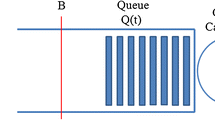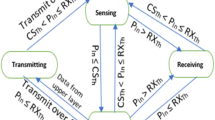Abstract
Since 1999 IEEE 802.11 has become a dominating wireless technology for providing WLAN in both public and private places. The protocol has evolved with time and the current version of protocol allows the maximum data rate up to 6.76 Gbps. Providing high data rate makes it capable of supporting applications demanding high bandwidth and less delay. The protocol is built on carrier sense multiple access with collision avoidance (CSMA/CA) principle to minimize the collisions. In real-time networks as the traffic increases, collisions take place between different flows leading to delay and wastage of bandwidth. In literature, various works are dedicated to predicting the collision probability to estimate available bandwidth of the network. One of the popular approaches “ABE” (Sarr et al. in IEEE Trans Mob Comput 7(10):1228–1241, 2008) focused on this issue and calculates collision probability of “Hello Packets” and interpolating it to get the collision probability of data packets to estimate the available bandwidth. The current work proposes to use an analytical approach to predict the collision probability without any intrusiveness and estimate the available bandwidth for accurate admission control. Most of the literature that uses mathematical approach assumed homogeneous conditions. The current paper takes into consideration heterogeneous conditions to resemble real networks. The paper proposes amalgamation of passive approach and analytical approach, yielding more accurate results. The work is verified through extensive simulations to validate our proposed model. Since the model is based on analytical approach, major benefits are: (a) there is no need to send packets for estimating the collisions, hence scaling down the overheads; (b) One can change the parameters and predict the result set for any given conditions; (c) the method is cost-effective and non-intrusive in nature.



























Similar content being viewed by others
References
Sarr, C., Chaudet, G., & Lassous, I. G. (2008). Bandwidth estimation for IEEE 802.11-based ad hoc networks. IEEE Transactions on Mobile Computing,7(10), 1228–1241.
Chaudet, C., & Lassous, I. G. (2002). BRuIT: Bandwidth reservation under interference influence. In Proceedings of the European wireless (EW’02), Florence, Italy (pp. 466–472). IEEE Press.
Yang, Y., & Kravates, R. (2005). Contention-aware admission control for ad hoc networks. IEEE Transactions on Mobile Computing,4(4), 363–377.
de Renesse, R., Ghassemian, M., Friderikos, V., Aghvami, A. H., et al. (2007). Cross-layer cooperation for accurate admission control decision in mobile ad hoc networks. IET Communications,1(4), 577–586.
Turrubiartes, M., Torres, D., Angulo, M., & Munoz, D. (2005). Analysis of IP network path capacity estimation using a variable packet size method. In 15th international conference on electronics, communications and computers (pp. 177–182).
Xiao, Y., Chen, S., Li, X., & Li., Y. (2007). A new available measurement method based on self-loading periodic streams. In International conference on wireless communications, networking and mobile computing, WiCom 2007, Shanghai, China (pp. 1904–1907).
Prasad, R. S., Murry, M., Dovrolis, C., Claffy, K. C., et al. (2003). Bandwidth estimation: Metrics, measurement techniques, and tools. IEEE Networks,17(6), 27–35.
Li, F., Li, M., Lu, R., Wu, H., Claypool, M., & Kinicki, R. (2006). Tools and techniques for measurement of IEEE 802.11 wireless networks. In 4th international symposium on modeling and optimization in mobile, ad hoc and wireless networks, Boston, MA, USA, (pp. 1–8).
Combs, G., et al. The wireshark network protocol analyzer. http://www.wireshark.org.
PRTG Network Monitor. https://www.paessler.com/prtg.
Solarwinds real-time bandwidth monitor. https://www.solarwinds.com/free-tools/real-time-bandwidth-monitor.
Solarwinds NetFlow Traffic Analyzer. https://www.solarwinds.com/netflow-traffic-analyzer.
BandwidthD. https://sourceforge.net/projects/bandwidthd.
Chaudhari, S. S., & Biradar, R. C. (2015). Survey of bandwidth estimation techniques in communication networks. Wireless Personal Communications,83(2), 1425–1476.
Dovrolis, C., Ramanathan, P., & Moore, D. (2001). What do packet dispersion techniques measure? In IEEE conference on computer communications (INFOCOM), Anchorage, Alaska, USA (pp. 905–914).
Lao, Li, Constantine, D., & Sanadidi, M. Y. (2006). The probe gap model can underestimate the available bandwidth of multihop paths. ACM SIGCOMM Computer Communication Review,36(5), 29–34.
Renesse, R. de., Ghassemian, M., Friderikos, V., & Aghvami, A. H. (2004). QoS enabled routing in mobile ad hoc networks. In 5th IEE international conference on 3G mobile communication technologies (IEE 3G) (pp. 678–682).
Zhao, H., Palacious, E. G., Wei, J., Yong, Xi, et al. (2009). Accurate available bandwidth estimation in IEEE 802.11-based ad hoc networks. Computer Communications,32(6), 1050–1057.
Chaudhari, S. S, & Biradar, R. C. (2014). Collision probability based available bandwidth estimation in mobile ad hoc networks. In Proceedings of the fifth international conference on applications of digital information and web technologies (ICADIWT), Chennai, India (pp. 244–249).
Belbachir, R., Mekkakia, Z. M., & Kies, A. (2011). Towards a new approach in available bandwidth measures on mobile ad hoc networks. Proceedings of Acta Polytechnica Hungarica,8(4), 133–148.
Nguyen, N. V., Lassous, I. G., Moraru, V., & Sarr, C. (2011). Retransmission-based available bandwidth estimation in IEEE 802.11-based multihop wireless networks. In Proceedings of the 14th acm international conference on modeling, analysis and simulation of wireless and mobile systems (pp. 377–384).
Chaudhari, S. S., & Biradar, R. C. (2015). Available bandwidth estimation using collision probability, idle period synchronization and random waiting time in MANET’s: Cognitive agent based approach. Wireless Personal Communications,85(3), 597–621.
Bianchi, G. (2000). Performance analysis of the IEEE 802.11 distributed coordination function. IEEE Journals on Selected Area in Communication,18(3), 535–547.
Bianchi, G. (1998). IEEE 802.11-saturated throughput analysis. IEEE Communications Letters,2(12), 318–320.
Wu, H., Peng, Y., Long, K., Cheng, S., & Ma, J. (2002). Performance of reliable transport protocol over IEEE 802.11 wireless LAN: Analysis and enhancement. In Proceedings of twenty-first annual joint conference of the IEEE computer and communication societies (pp. 599–607).
Chatzimisios, P., Boucouvalas, A. C., & Vitas, V. (2005). Performance analysis of IEEE 802.11 MAC protocol for wireless LANs. International Journal of Communication Systems,18(6), 545–569.
Ziouva, E., & Antonakopoulos, T. (2002). CSMA/CA performance under high traffic conditions: Throughput and delay analysis. Journal of Computer Communications,25(3), 313–321.
IEEE 802.11. (1999). IEEE standard for wireless LAN medium access control (MAC) and physical layer (PHY) specifications: Higher-speed physical layer extension in the 2.4 GHz band. IEEE standard 802.11b, September 1999.
Foh, C. H., & Tantra, J. W. (2005). Comments on IEEE 802.11 saturation throughput analysis with freezing of backoff counters. IEEE Communication Letters,9(2), 130–132.
Li, Y., Wang, C., Long, K., & Zhao, W. (2008). Modeling channel access delay and Jitter of IEEE 802.11 DCF. Wireless Personal Communications,47, 417–440.
Li, Y., Ke-Ping, L., Wei-Liang, Z., & Qian-Bin, C. (2006). A novel random backoff algorithm to enhance the performance of IEEE 802.11 DCF. Wireless Personal Communications,36(1), 29–44.
Li, Y., Wang, C., & You, X. (2009). The Jamming problem in IEEE 802.11-based mobile ad hoc networks with hidden terminals: Performance analysis and enhancement. International Journal of Communication Systems,22(8), 937–958.
Kumar, P., & Krishan, A. (2010). Saturation throughput analysis of IEEE 802.11 b wireless local area networks under high interference considering capture effects. International Journal of Computer Science and Information Security, IJCSIS,7(1), 32–39.
Daneshgaran, F., Laddomada, M., Mesiti, F., Mondin, M., et al. (2008). Unsaturated throughput analysis of IEEE 802.11 in presence of non-ideal transmission channel and capture effects. IEEE Transaction on Wireless Communications,7(4), 1276–1286.
Xu, X., & Lin, X. (2006). Throughput enhancement of the IEEE 802.11 DCF in fading channel. In IEEE international conference on wireless and optical communications networks. IEEE, Banglore, India.
Yin, J., Wang, X., & Agrawal, D. P. (2006). Impact of bursty error rates on the performance of wireless local area networks (WLAN). Ad Hoc Networks,4(5), 651–668.
Liaw, Y. S., Dadej, A., & Jayasuriya, A. (2005). Performance analysis of IEEE 802.11 DCF under limited load. In Proceedings of Asia-Pacific conference on communications, Australia (pp. 759–763).
Malone, D., Duffy, K., & Leith, D. (2007). Modeling the 802.11 distributed coordination function in nonsaturated heterogeneous conditions. IEEE/ACM Transaction on Networking,15(1), 159–172.
Dhanasekaran, S., & Krishan, A. (2010). Nonsaturation throughput enhancement of IEEE 802.11b distributed coordination function for heterogeneous traffic under noisy environment. International Journal of Automation and Computing,7(1), 95–104.
Laddomada, M., Mesiti, F., Mondin, M., & Daneshgaran, F. (2010). On the throughput performance of multirate IEEE 802.11 networks with variable-loaded stations: Analysis, modeling, and a novel proportional fairness criterion. IEEE Transaction on Wireless Communications,9(5), 1594–1607.
Kumar, A., Altman, E., Miorandi, D., Goyal, M., et al. (2007). New insight from a fixed point analysis of single cell IEEE 802.11 WLAN. IEEE/ACM Transaction on Networking,15(3), 588–601.
Zhao, Q., Tsang, D. H. K., & Sakurai, T. (2009). A simple and approximation model for non-saturated IEEE 802.11 DCF. IEEE Transaction on Mobile Computing,8(11), 1539–1553.
Cali, F., Conti, M., & Gregori, E. (2000). Dynamic tuning of the IEEE 802.11 protocol to achieve a theoretical throughput limit. IEEE/ACM Transactions on Networking,8(6), 785–799.
Cali, F., Conti, M., & Gregori, E. (2000). IEEE 802.11 Protocol: Design and performance evaluation of an adaptive backoff mechanism. IEEE Journal on Selected Areas in Communications,18(9), 1774–1786.
German, R., & Heindi, A. (1999). Performance evaluation of IEEE 802.11 wireless LANs with stochastic Petri Nets. In proceedings 8th international workshop on petri nets and performance models, PNPM’99. IEEE, Zaragoza, Spain (pp. 44–53).
Jayaparvarthy, R., Anand, S., Dharmaraja, S., & Srikanth, S. (2007). Performance analysis of IEEE 802.11 DCF with stochastic reward nets. International Journal of Communication Systems,20(3), 273–296.
Younes, O., & Thomas, N. (2013). Modelling and performance analysis of multi-hop ad hoc networks. Simulation Modelling Practice and Theory,38, 69–97.
Yadollahzadeh Tabari, M., & Pouyan, A. A. (2017). Misbehavior analysis of IEEE 802.11 MAC layer in mobile ad hoc network using stochastic reward nets. International Journal of Communication Systems,30(16), e3385.
Hu, X., Jiao, L., & Li, Z. (2016). Modelling and performance analysis of 802.11 using Coloured Petri Nets. The Computer Journal, OUP,59(10), 1563–1580.
Masri, A., Bourdeaudhuy, T., & Toguyeni, T. (2009). Performance analysis of IEEE 802.11 wireless networks with object oriented Petri Nets. Electronic Notes in Theoretical Computer Science,242(2), 73–85.
Li, Y., Wang, C., You, X., Zhao, W., & Sohraby, K. (2011). Spare node cooperative method for IEEE 802.11 networks. Wireless Networks,17(3), 671–683.
Li, Y., Zhang, Z., Wang, C., Zhao, W., & Chen, H. (2013). Blind cooperative communications for multihop ad hoc wireless networks. IEEE Transactions on Vehicular Technology,62(7), 3110–3122.
Li, Y., Song, S., & Daneshmand, M. (2016). A store-and-forward cooperative MAC for wireless ad hoc networks. Mobile Networks and Applications,21(6), 1024–1031.
Hoang, T.-M., Bui, V.-K., & Nguyen, T.-T. (2017). The performance evaluation of an IEEE 802.11 network containing misbehavior nodes under different backoff algorithms. Security and Communication Networks,2017, 2459780.
Swain, P., Chakraborty, S., Nandi, S., & Bhaduri, P. (2014). Performance modeling and evaluation of IEEE 802.11 IBSS power save mode. Ad Hoc Networks,13, 336–350.
Soares, M. S., & Carvalho, M. M. (2017). Revisiting the analytical modeling of the IEEE 802.11 power save mode for independent basic service sets (IBSS). In PE-WASUN’17 Proceedings of the 14th ACM symposium on performance evaluation of wireless ad hoc, sensor, and ubiquitous networks, Miami, Florida, USA (pp. 17–24).
Bozkurt, A. (2016). Optimal delay analysis for real-time traffics over IEEE 802.11 wireless LANs. EURASIP Journal on Wireless Communication and Networking,52, 1–13.
Lepaja, S., Maraj, A., & Berzati, S. (2019). WLAN planning and performance evaluation for commercial applications. Data-Centeric Business and Applications,20, 53–69.
Eyadeh, A., Jarrah, M., & Aljumaili, A. (2019). Modeling and simulation of performance limits in IEEE 802.11 point-coordination function. International Journal of Recent Technology and Engineering (IJRTE),8(4), 5575–5580.
Gupta, N., & Rai, C. S. (2014). Performance evaluation of IEEE 802.11 DCF in single hop ad hoc networks. Wireless Personal Communication Journal,79(3), 2171–2193.
Belbachir, R., Mazza, Z. M., Kies, A., & Belhadri, M. (2013). Collision’s issue: Towards a new approach to quantify and predict the bandwidth losses. In Global information infrastructure symposium—GIIS 2013, IEEE, Trento, Italy (pp. 1–4).
Shadrin, A. (1995). Error bounds for lagrange interpolation. Journal of Approximation Theory,80, 25–49.
Author information
Authors and Affiliations
Corresponding author
Additional information
Publisher's Note
Springer Nature remains neutral with regard to jurisdictional claims in published maps and institutional affiliations.
Rights and permissions
About this article
Cite this article
Mukta, Gupta, N. Analytical approach towards available bandwidth estimation in wireless ad hoc networks. Wireless Netw 26, 2957–2982 (2020). https://doi.org/10.1007/s11276-020-02249-8
Published:
Issue Date:
DOI: https://doi.org/10.1007/s11276-020-02249-8




